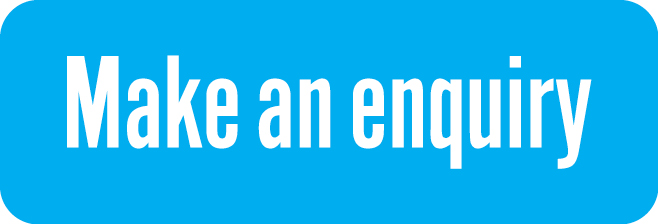Making sense of COVID-19: Dynamic Pathway Planning
by Dr Marc Levy & Zoe Pappas
Please note: Strategic Facilitators is the workshop facilitation arm of our management consulting practice Right Lane Consulting. To find out more about Right Lane visit www.rightlane.com.au
Facing uncertainty, scenario planning methods come into their own. In this article, we apply our own Dynamic Pathway Planning methodology to illustrate its practical application for organisations seeking to make sense of COVID-19.
With the COVID-19 pandemic and isolation measures disrupting organisations, their customers and suppliers, and it being the time of the year executives are intensively undertaking planning and budgeting work, we are doing a considerable amount of scenario planning work right now.
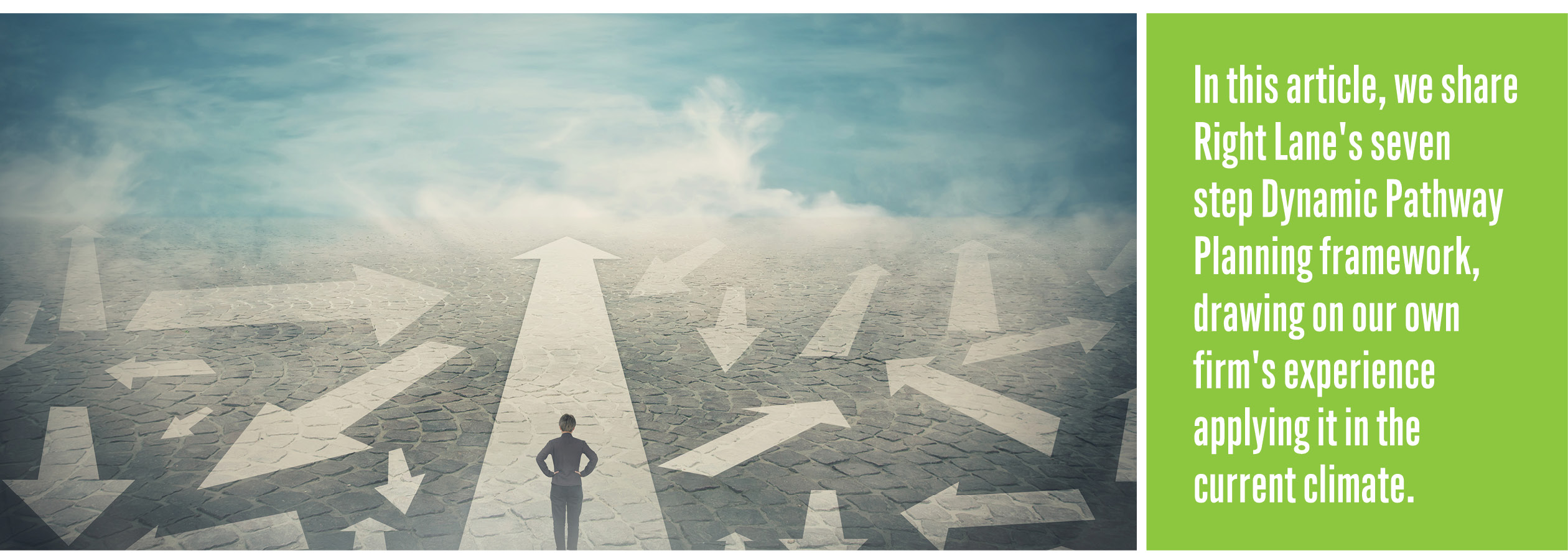
We’ll be honest – scenario planning hasn’t been our favourite strategy framework, in no small part because the way it’s often used lacks true purpose, context and clarity. Often the scenarios that organisations craft are too improbable and farfetched, or there’s been too much focus on the front end – crafting clever combinations of trends and events – and not enough focus on the back end such as considering the different planning responses, or the monitoring and review disciplines required to determine when to change tack as the future plays out.
Other strategy frameworks do a better job when conditions are more predictable, but scenario planning, and derivatives
thereof, can come into its own under conditions of uncertainty. A pervasive pandemic like COVID-19 (similar to a war or a collapse in financial markets) raises the level of uncertainty for everyone.
In this article, we share Right Lane’s seven step Dynamic Pathway Planning framework, drawing on our own firm’s experience applying it in the current climate. We’ve focused on our firm’s application of the framework, because our client examples are confidential, and also because we have found it extremely helpful in aligning our Leadership Team in these challenging times.
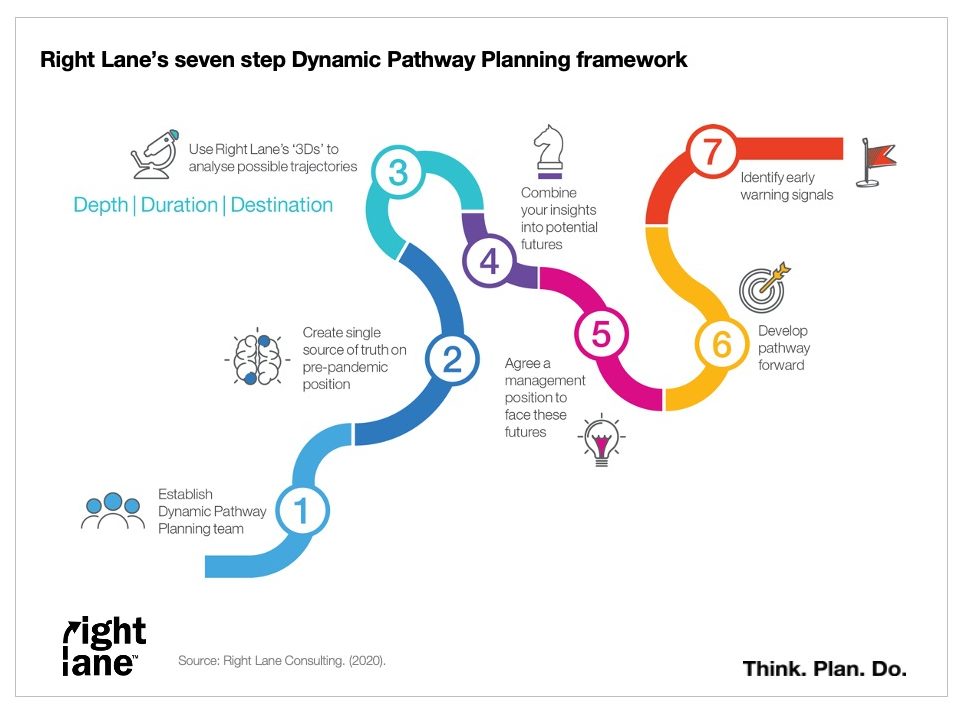
Step 1: Establish the Dynamic Pathway Planning team
At Right Lane, the first thing we did was to form a Dynamic Pathway Planning team and establish some parameters. In our case, we decided the Leadership Team was the right group to do this work.
We distinguished this forward-looking effort from the work of the ‘pandemic response’ team that is responding to the immediate priorities of evolving our COVID-19 policies, getting our people set up remotely and facilitating new ways of working.
Step 2: Create the single source of truth on your pre-pandemic position
For this second step, we reviewed our strategy, plans and the progress of our key initiatives. We also took a step back to recap the key performance trends we’d been experiencing pre-pandemic – our track record of revenue growth, steady increases in average engagement size, deeper client relationships and a more diversified revenue base – to give us a solid understanding of our pre-COVID-19 position and trajectory. We then paid particular attention to our immediate future performance indicators – establishing our cash and debtors positions, our year to date profit margin and our pipeline of new work. Being aligned on our pre-pandemic position gave us a solid foundation for thinking about the possible futures that lie in front of us.
Step 3: Gain a greater appreciation of possible COVID-19 trajectories using Right Lane’s ‘3Ds’
In step 3, we analysed the ‘3Ds’ of the pandemic as they were impacting our operating environment, industry and firm – that is, the depth, duration and destination of the pandemic.
In our case we are most concerned about the longevity of disruption to demand patterns. Some of our clients have pushed out strategy discussions or delayed projects. Will demand ‘snap back’ to where it was before the pandemic, or will there be a long-term disruption to demand patterns? If it will ‘snap back’, when might that be – when everyone goes back to the office, when clients’ finances improve or when organisations decide they want to catch up on longer-term initiatives?
We also discussed opportunities presented by the current situation, including our post-COVID-19 mission or ‘moon shot’ as Sam Mostyn has called it (Mostyn, 2019).
What kind of organisation do we want to be, on the other side of this disruption? Our moon shot ideas centred on opportunities for our clients, our own firm’s growth and some of our new ways of working.
Step 4: Combine your insights from the 3Ds analysis into potential futures
Exploring the 3Ds of the pandemic gave rise to four ‘potential futures’ we believe we might face, represented by the matrix below in exhibit 1, with depth of disruption (demand patterns go back to ‘normal’ or they don’t) on the y-axis and duration of disruption (3-6 months and greater than 6 months) on the x-axis.
Exhibit 1: Right Lane’s four potential futures
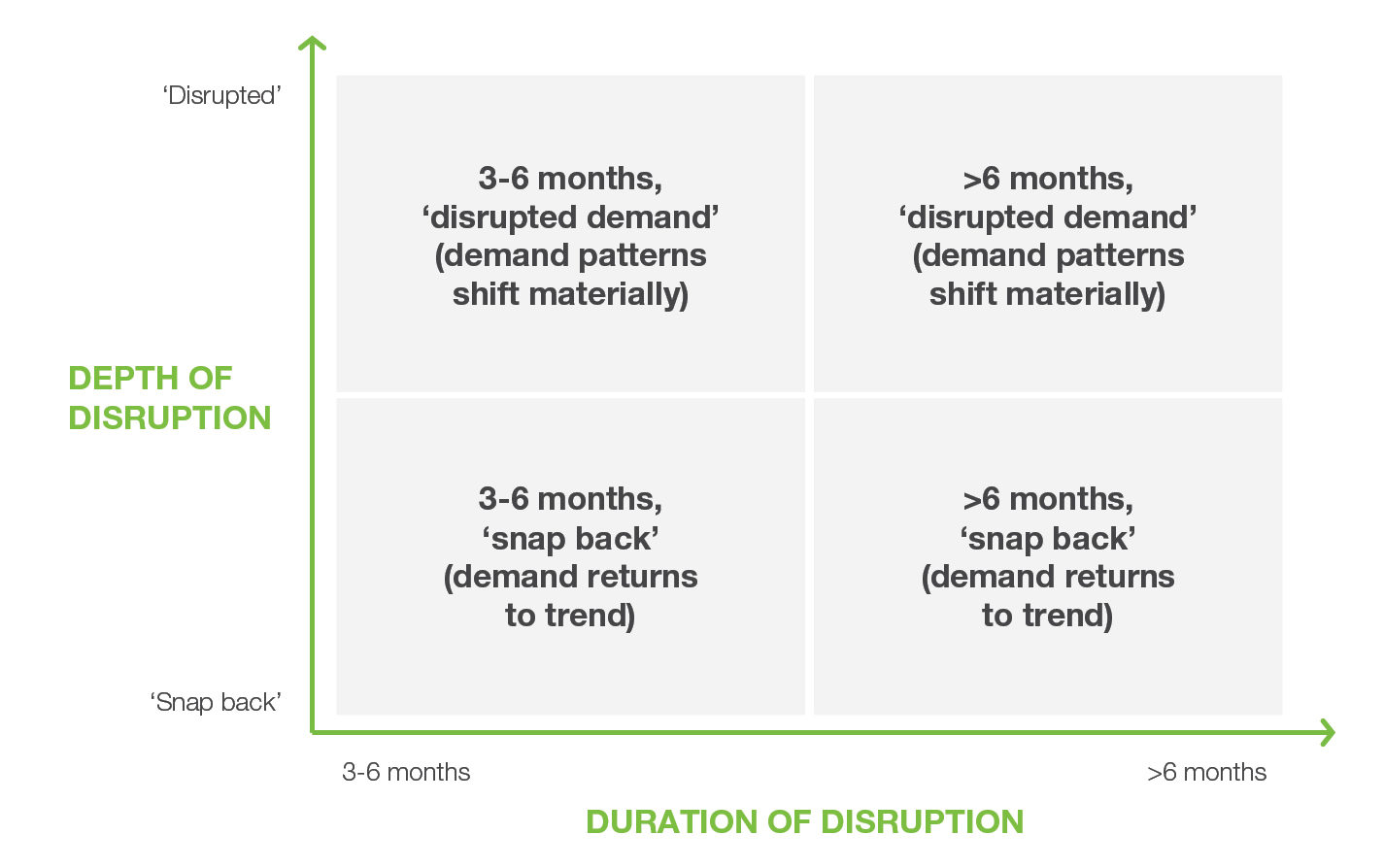
Source: Right Lane Consulting. (2020).
For clarity, deep disruption might include clients wanting different services than the ones we provided pre-pandemic, or wanting to engage with us in different ways.
We examined the implications of each ‘future’ for our strategy, operating model and financial position. A high-level snapshot of this analysis is shown in exhibit 2.
Exhibit 2: Possible futures based on analysis of the 3Ds (Not exhaustive)
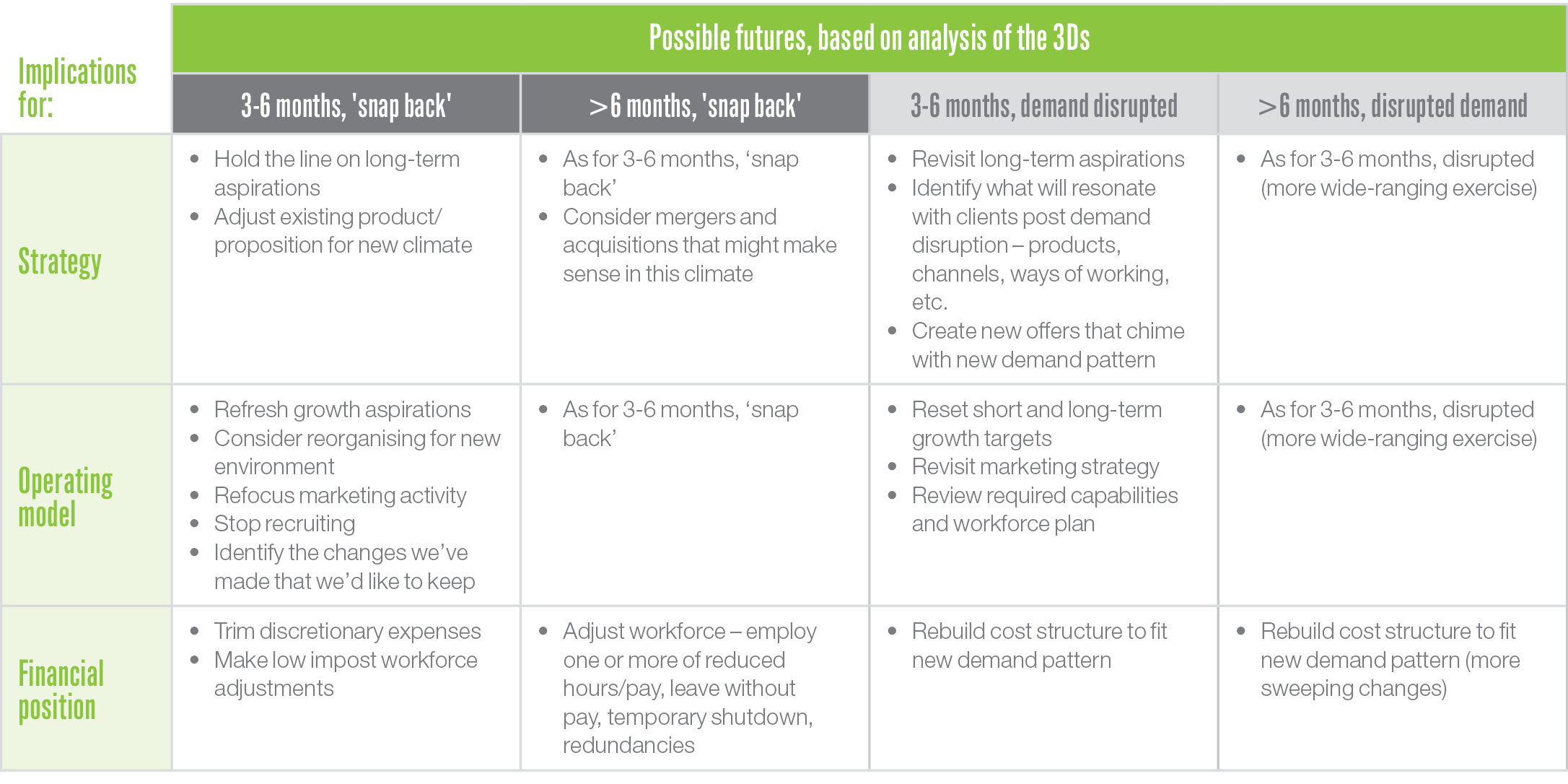
Source: Right Lane Consulting. (2020).
Step 5: Agree a general position management will take to face into these futures
Having established these possible futures and the implications, we agreed our general position via a set of principles: keep our people feeling purposeful, productive and connected; always consider what we want Right Lane to look like on the other side of this; preserve the cash we’ve built up in the firm as best we can; and make workforce adjustments only when necessary, not pre-emptively.
We agreed to plan in six-week blocks, reviewing progress weekly.
Step 6: Develop the pathway forward
We then developed a plan that’s robust to the four futures and flexible enough to adapt as things change.
We made the changes suggested by the least disruptive, 3-6 month, ‘snap back’ future. For example, we ‘atomised’, establishing smaller teams to help our people stay connected and create purposeful, productive individual work programs. We refocused our marketing activity with the emphasis on staying connected with existing clients. We fine-tuned our existing product propositions so that they would resonate more in the current climate. We made ‘low impost’ workforce adjustments such as asking people to use up their time-off-in-lieu if they were unable to maintain a threshold level of productivity.
With an eye to possible disruption to demand patterns, we decided to maintain our investment in our strategy workshops service, which will always be in demand; we launched initiatives to create new offers that might resonate with clients under different circumstances; and we intensified discussions with potential merger partners with value propositions that might complement ours in a disrupted environment.
Step 7: Identify early warning signals and adapt in the face of new developments
We set expectations for the next six-week period covering revenue, pipeline, cash, profit margin and utilisation, twelve measures in all, and developed a dashboard to monitor these measures in our regular Leadership Team meetings. We agreed that should we meet those expectations, we would not make workforce adjustments.
Agreeing to these measures – along with targets and ‘early warning signals’ that identify whether significant, prolonged disruption is playing out – has brought focus and agility to our weekly Leadership Team Dynamic Pathway Planning discussions. By monitoring these signals we will have alignment on when we might need to adapt our plans and change tack as the situation evolves. We understand that it is quite likely that the ‘other side’ will be characterised by ‘fits and starts’, and still further economic uncertainty – the ‘dance’ as Tomas Pueyo called it (Leonhardt, 2020), and so we are likely to need to be highly adaptive in response.
***
We’ve found that Dynamic Pathway Planning helps bring clarity to an otherwise opaque set of circumstances and provides a practical and action-oriented method that’s often absent in typical scenario planning. It aligns teams, enriches and invigorates decision making and reduces the anxiety involved in working in uncertain times.
We think you’ll also benefit from embedding Dynamic Pathway Planning in your organisation.
Want to know more? Join our free webinar
Join Zoe Pappas and Chiara Lawry as they further discuss the application of our Dynamic Pathway Planning methodology and how organisations can use this to make sense of COVID-19 and develop their medium-term recovery plan.
Friday 22nd May AEST 1:00pm – 1:30pm
CLICK HERE TO REGISTER
References
Courtney, H., Kirkland, J., & Viguerie, P. (1997). Strategy Under Uncertainty. Harvard Business Review. Retrieved from https://hbr.org/1997/11/strategy-under-uncertainty
Leonhardt, D. (2020, April 10). It’s going to be difficult. New York Times. Retrieved from https://www.nytimes.com/2020/04/10/opinion/coronavirus-social-distancing.html
Mostyn, S. (2019, October 19). Mobilizing for a climate moonshot – @MazzucatoM on using mission-thinking across all sectors to tackle climate change: https://www.marketwatch.com/story/mobilizing-for-a-climate-moonshot-2019-10-15 [Tweet]. Retrieved from https://twitter.com/centrepolicydev/status/1186066219956195328
Want to know more?
For more information please contact us below or call the office on 03 9428 8817.

